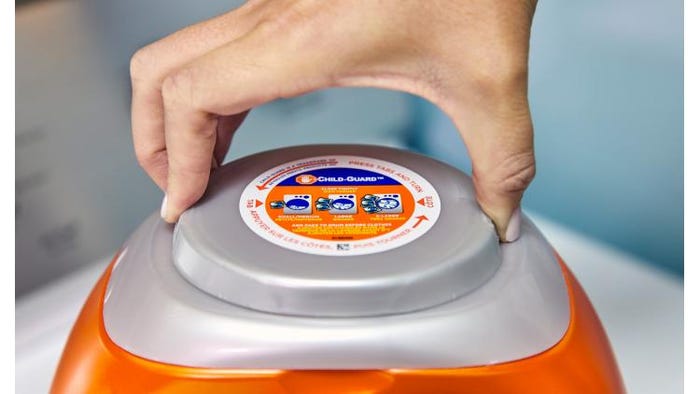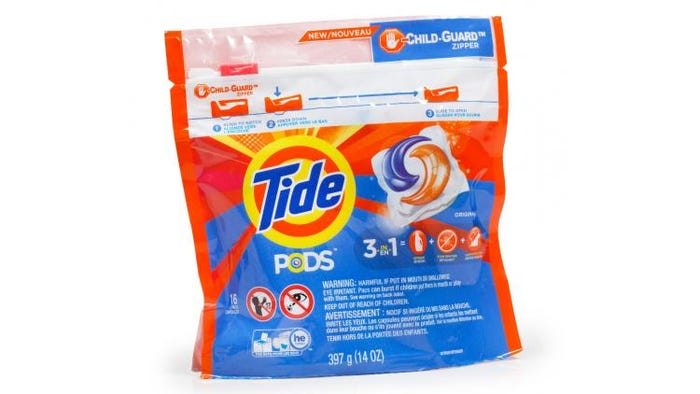P&G develops child-resistant closure for tubs of laundry pods
Efforts to prevent poisonings related to Procter & Gamble’s liquid laundry pacs continue with the company’s latest packaging innovation: a harder-to-open Child-Guard closure on tubs of Tide PODS and Gain Flings.
The previous triple-latch closure was already a child deterrent, but the new child-resistant closure makes it even more difficult for children to open the tub to gain access to the laundry pods, according to the company.
This is just the latest packaging improvement to help reduce the number of ingestion accidents and ensure product safety. In 2016, P&G introduced the first child-resistant pouch with a Child-Guard zipper, added a bitter-tasting substance to the outer film as a deterrent and beefed up the strength of the pac's film to delay product release.
The packaging improvements are working: P&G reports a 39% reduction of incidences related to its liquid laundry pacs in the last available 12 months compared to the baseline set by ASTM Intl. (baseline is from the period of July 2012 through June 2013).
In a press release announcing this new closure, Sundar Raman, North America vp of fabric care for P&G, said: ��“Nothing is more important to us than the safety of the families who use our products. Since last year’s launch of the innovative Child-Guard bag for liquid laundry pacs, we’ve been working hard to launch this same technology for our tubs. Knowing that access is a key factor in accidental exposures, we’ve made the new Child-Guard tub easy to close, but harder to open so parents and caregivers can both conveniently and safely store the product, further driving down accidents. With this key change, child-resistant packaging will now be available for all of our laundry pac products.”
Elizabeth Kinney, senior communications manager, Procter & Gamble North America Fabric Care, gives Packaging Digest more details about the updated packaging.
What testing did you do on the new closure to ensure it works as designed to provide child resistance and what were the results?
Kinney: To create this child-resistant lid, we conducted in-depth consumer research, product development and testing over a period of three years. We followed the Poison Prevention Packaging Act’s protocol, used by the Consumer Product Safety Commission (CPSC).
The new Child-Guard lids were put through internal and external evaluations with hundreds of children and families to ensure they meet the PPPA’s child-resistant criteria. This means that in testing the lid with children under the age of six, more than 90% of them were unable to open it, even after being instructed in exactly how to do so.
Was the closure also tested with seniors?
Kinney: Yes, as required by the PPPA, the new closure was tested with a cross-section of the older adult population.
What is the size of the closure?
Kinney: The Child-Guard lid is 4-1/4 inches wide and 3-3/4 inches tall.
How much force is required to open it? How hard is it for adults to open the package?
Kinney: The new lid requires individuals to perform multiple cognitive and manipulative steps to open—squeezing both sides of the lid and twisting at the same time to remove. To see a video of the opening and closing, click here.

The new child-resistant closure requires consumers to squeeze, hold and twist to open. Clear instructions are displayed on top of the lid.
How is this CR closure safer than the previous one?
Kinney: The triple-latch enclosures on our tubs are already child-deterrent, but child-resistant packaging makes the tubs even more difficult for children to access.
We previously developed a child-resistant bag for Tide PODS, which features a Child-Guard zipper and is widely available in stores. We believe a collective approach that emphasizes education alongside harder-to-open packaging is vital to continue reducing accidental exposures from liquid laundry pacs.
How do you measure the 39% reduction in the rate of accidents related to P&G’s liquid laundry pacs?
Kinney: A standard for liquid laundry pacs was developed through ASTM International in 2015, which is intended to bring a uniform set of safety guidelines to the industry. To measure the effectiveness of the standard, the ASTM Standard team agreed to baseline period of July 2012 through June 2013. The 39% reduction in the incident rate is measured by comparing data from the last available 12 months to the baseline set by ASTM.
It looks like the closure can be completely removed from the tub, correct?
Kinney: Yes, by squeezing both sides of the lid and twisting at the same time, the lid can be opened to remove laundry pacs for use. The lid should always be closed by an adult immediately after the laundry pacs are removed, and the entire tub should be stored up, closed and away from children.
What changes were made to the tub itself to accommodate this new closure?
Kinney: As mentioned above, the lid and related instructions were the only changes made to the tubs to accommodate the new closure.
Is there an audible sound to indicate when the closure is resealed correctly?
Kinney: Yes, as seen in this short video, there is a “click” to signal the correct closure of the tub.
What consumer education initiatives will P&G be doing for this package?
Kinney: To support the launch of the Child-Guard tub, P&G will continue its national educational campaign featuring multi-media advertisements and content partnerships with leading online parenting channels to help increase awareness and drive education on how to safely use and store liquid laundry pacs.
Would you consider making any changes to the color of the tub and/or pacs?
Kinney: The tubs have been modified significantly since launch, with one key change being the shift in the tub itself from translucent to opaque material.
We have looked into color, and according to a study of US Poison Control Center data, color does not play a critical role in accidental exposures to laundry pacs. A key driver in accidental exposures is access to the product, so we have focused many of our efforts on preventing access through the introduction of child-resistant packaging.
What changes, if any, were made to the packaging line to apply the new closure?
Kinney: Yes, changes were made to accommodate these new lids, but we do not disclose proprietary details related to our packaging lines.
Who holds the trademark for “Child-Guard”?
Kinney: Presto Products holds the trademark for Child-Guard. We worked with Presto Products to develop the Child-Guard zipper for bags of liquid laundry pacs. This zipper is child-resistant, and was released in 2016.

P&G will still keep its child-resistant pouch for laundry pacs.
Will this tub replace the pouch or is it in addition to the pouch with the Child-Guard zipper?
Kinney: The Child-Guard zipper bag will remain in the market along with the tub. We offer both types of packaging because they provide different quantities and storage styles for different people and family needs.
How many stock-keeping units (SKUs) for Tide and Gain will use this new package?
Kinney: All P&G liquid laundry packet tubs will be converted to the new Child-Guard lids. Full retail conversion will vary by store in a phased roll out, but we expect many stores to carry the new Child-Guard tubs by the end of 2017.
Is the closure the same color for all SKUs?
Kinney: No, consistent with our current lids, the new lid will be silver on the “Tide +” collection, orange on Tide Original, Spring Meadow and Ocean Mist, and light blue on Tide Free & Gentle.
How are you communicating this new packaging feature to consumers?
Kinney: In addition to sharing the news with all media, we have ongoing education programming, updated safety videos on our digital platforms, updated television ads and a strong partnership with leading organizations—including Safe Kids Worldwide and the American Cleaning Institute—to help us connect with experts and reach even more parents through shared programs and resources.
Why are the opening instructions on the package in two languages? English and French, correct?
Kinney: The opening instructions are in English and French to meet the needs of both U.S. and Canadian consumers. Additionally, we have safety resources, programming and targeted outreach to Spanish-speaking consumers.
Are the opening instructions printed on a label, which is then applied to the top of the package, or is that an in-mold label? If an applied label, what is the label material and how is it printed?
Kinney: The instructions are printed on a pressure-sensitive label, using flexographic technology.
********************************************************************************************
Learn what it takes to innovate in the packaging space at MinnPack 2017 (Nov. 8-9; Minneapolis). Register today!
About the Author(s)
You May Also Like




